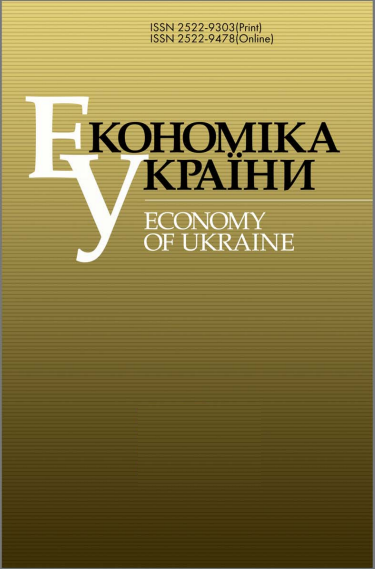UKRAINIAN ECONOMY AND ECONOMIC POLICY
DOI:
https://doi.org/10.15407/economyukr.2025.01.020Keywords:
structure of the economy; economic growth; macroeconomic stability; central bank policy.Abstract
Wars, while always being a tragedy, often become a catalyst for many social and economic processes. The full-scale war also served as such a "driver" for the discussion about the economic model of Ukraine which will allow it to withstand the protracted confrontation with the Russian Federation, and what it should become after the end of the war. Making effective recommendations on how to revive economic growth and what role the central bank can play in this process requires finding out how the Ukrainian economy was changing after integration into the world economic system, and in what state it was at the beginning of the war and during the time of full-scale aggression.
Changes in the Ukrainian economy over the past 15 years have been analyzed, based thereon, certain measures to support economic growth in wartime conditions and the role of the central bank's policy in this process have been determined. The research used such methods as comparison and juxtaposition, system analysis, deduction and graphic interpretation. Changes in the structure of Ukraine's economy have been analyzed in dynamics – from the global financial crisis of 2008 through 2021–2023 (the last available data). It is pointed out that there is a risk of economic policy moving along “the path of least resistance”, which today can manifest in the formal fulfillment of only the obligations necessary to receive financial assistance. The positive is that the constant crises have made Ukrainian business extremely resistant to shocks and upheavals, which allows economic agents to quickly adapt to changing external and internal conditions. The same logic applies to economic policymakers in Ukraine.
References
Shuvanov, A. (2021). Theoretical approaches to the structuring of the national economy. State Formation. No. 1 (30). https://doi.org/10.34213/db.21.01.27 [in Ukrainian].
Khodzhaian, A. (2018). Structural characteristics of Ukrainian economy development. Economic Bulletin of the National Mining University. No. 4. P. 71-83. URL: http://www.irbis-nbuv.gov.ua/cgi-bin/irbis_nbuv/cgiirbis_64.exe?I21DBN=LINK&P21DBN=UJRN&Z21ID=&S21REF=10&S21CNR=20&S21STN=1&S21FMT=ASP_meta&C21COM=S&2_S21P03=FILA=&2_S21STR=evngu_2018_4_9 [in Ukrainian].
Shovkun, I. (2016). Neo-industrialization in Ukraine: are there macroeconomic background and investment potential? Economy and forecasting. No. 4. P. 48-69. https://doi.org/10.15407/eip2016.04.048 [in Ukrainian].
Malthus, R. (1798). An essay on the principle of population. London. 134 p. URL: http://www.esp.org/books/malthus/population/malthus.pdf
Keynes, J. (1939). The General Theory of Employment, Interest, and Money. International relations and security network. 190 p. URL: https://www.files.ethz.ch/isn/125515/1366_keynestheoryofemployment.pdf
Fikri, Y., Rhalma, M. (2023). Sustainable development: Theoretical Review. International Journal of Accounting, Finance, Auditing, Management and Economics. URL: https://www.ijafame.org/index.php/ijafame/article/view/1021/1110
Algan, Y., Cahuc, P. (2013). Trust and Growth. Annual Review of Economics. Vol. 5. P. 521-549. https://doi.org/10.1146/annurev-economics-081412-102108
Downloads
Published
How to Cite
Issue
Section
License
Copyright (c) 2025 Publisher PH «Akademperiodyka»

This work is licensed under a Creative Commons Attribution-NonCommercial-NoDerivatives 4.0 International License.



